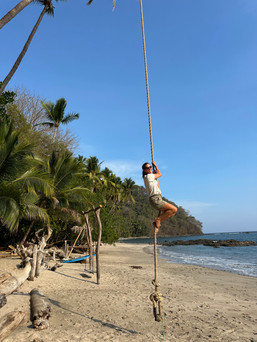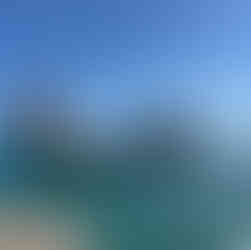What Makes a Good Anchorage?
- Kay Hunt
- Apr 8
- 5 min read
We recently calculated that we have spent 388 nights at anchor, so we thought it would be interesting to reflect on what makes a good anchorage.

Swell Protection: Having a mediocre night’s sleep and seeing one’s morning coffee launch across the counter because the boat is in a very rolly anchorage is a rough start to any day, so swell protection is important. It is difficult to always be completely shielded from swell, since it tends to wrap around capes and work its way into all the nooks and crannies of a coastline, so we employ our flopper stopper often to dampen side to side boat rocking if needed. Sometimes we will tolerate a night of rolling in order to experience a special place, but we usually make a quick exit once we are done. We recently spent a rolly night in Montezuma, Costa Rica, a very interesting, authentic small town with a fantastic hike to a waterfall and swimming hole. It was completely worth it for one night, but overall, a spot well-protected from most swell is an important feature of the best anchorages.

Wind protection: In the case of wind, we prefer a happy medium. We definitely want good protection from strong gusty winds by adjacent land masses. However, we find that the boat can become stiflingly hot, especially in the tropics, if there is no breeze. This is often the case in tight marinas or inland waterways. In established anchorages with many boats, we will seek a spot on the outer edge to maximize our breeze. A breeze will also help keep mosquitos and other bugs away.

Shore Access: In order to make living on a boat sustainable, the ability to get OFF the boat often is important, daily is ideal. This enables us to get needed exercise, explore local areas, get food and supplies, and perhaps enjoy some alone time. This may mean an easy shore landing on paddleboards or the dinghy, tying up to a public pier, a marina with an accessible dinghy dock, or putting the big boat in a marina for a few days. Thick forest and barnacle covered shoreside rocks (British Columbia’s Broughton area) or high surf (Tamarindo, Costa Rica) can thwart shore access.

Shoreside Amenities: Once we make it onshore, what’s there? We really enjoy exploring towns of all sizes—eating at local restaurants, shopping at markets, walking the local streets. This includes towns as small as Walter’s Cove, BC and as large as San Francisco, CA. We especially enjoy historical landmarks or museums where we can learn about an area’s past. If we’re lucky we may find some local music to enjoy. Other favorite stops are beaches, parks or natural reserves that have trails where we can enjoy the local wildlife, terrain, and ecology. Today we had a great hike and wildlife viewing in the Curu Wildlife Refuge accessed via the beach in the Curu Anchorage on Costa Rica’s Nicoya Peninsula.

Scenic Beauty: Appreciating the beauty of a location from the unique perspective of the water is a cruiser’s special privilege. Some of the most memorable anchorages we have experienced have been spectacularly beautiful, whether it be the land, the water, the sky or the life. The tidepool life and sand formations on Sucia Island in the San Juans, the eagles, cliffs and waterfalls in Princess Louisa Inlet BC, the town lights and mountains of Avalon Harbor on Catalina Island, and the turquoise water of Isla San Francisco in the Sea of Cortez are just a select few of the best.

Water Clarity: The best anchorages have good water clarity. This allows us to make water without fear of clogging our filters, have pleasant swimming or snorkeling, and minimize growth on the bottom of our boat, anchoring apparatus, and dinghy. Anchorages near river inlets tend to be murky, as are lagoons or areas with little water exchange. Barra de Navidad’s lagoon anchorage was miserably hot, murky, and buggy, so we made a hasty exit to the nearby marina where we could use our AC while we enjoyed the great town and refreshing marina pool. Mexico’s Sea of Cortez and Columbia Cove on Vancouver Island’s west coast get the prize for having the most beautiful, clear water we have experienced so far.

Fellow Cruisers: It’s really nice to share an anchorage with a few other cruising boats. We enjoy the socializing, trading stories and tips about the area, and appreciate the security of having other boats nearby. This is another category where on average we prefer a happy medium. We do enjoy the occasional anchorage all to ourselves where we can soak in beautiful remote places with just the wilds around us. Those are special spots, but we would get bored and lonely if this was all we did. We have also enjoyed a few popular spots where we are sharing the anchorage with 50-100 other cruising boats. These places are also fun and usually popular for a good reason, like the stunning beauty of Prideaux Haven, British Columbia, but after a few days we begin longing for a little more elbow room. Overall, it’s a balance, but hanging out in a beautiful spot with the company or two or three others is my favorite.

Local Boat Traffic: Some anchorages are tour boat destinations, like Isla Grande near Zihuatenejo, Mexico, and Isla Tortuga, Costa Rica. What is a quiet morning and nighttime location may become filled with crowded tour boats arriving from nearby resorts for a snorkel tour, sunset cruise, beach or island visit. This doesn’t bother us too much, but in defining the best anchorages, I’d pick the ones that don’t have a steady coming and going of tourists and tour boats. Anchorages in front of smaller towns are often filled with small, local fishing boats or pangas. We respect their space and try to remain out of their way. Unfortunately, in some areas, permanent mooring fields of abandoned or derelict vessels fill the anchoring room, presenting an eyesore and environmental hazard. This is a particular problem in Canada’s Gulf Islands. The otherwise beautiful Burgoyne Bay and Ganges Harbor were notable for their clusters of such boats.


How do we find the good spots? Many people ask us this question. We start with guidebooks for cruisers which outline regions and review anchoring options. As we have moved south into Mexico and Central America, cruising apps such as “No Foreign Land” have become an excellent source of information. Cruisers like us leave reviews and pictures, offering up to date information about anchorages and shoreside highlights. We also have a Garmin electronic chart app which also allows for users to leave reviews and comments which become a visible part of the chart. We have relied greatly on these apps lately, so have made a point to leave more reviews of the places we go for those coming along after us.



























































Comments